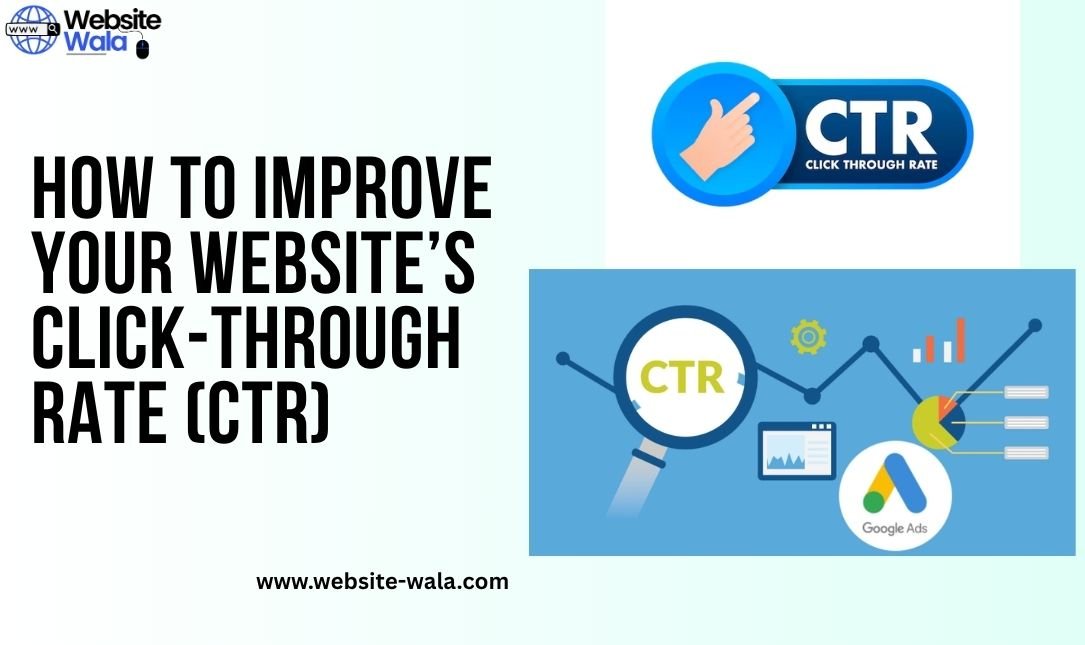
Learn How to Improve Your Website’s Click-Through Rate (CTR) with effective strategies to attract more clicks and drive traffic efficiently.
Introduction
In today’s digital landscape, website performance is not just about traffic but the quality of user engagement. One key metric that reflects this is the click-through rate (CTR). Understanding how to improve your website’s click-through rate (CTR) is crucial for businesses aiming to drive traffic and convert visitors into loyal customers. A higher CTR indicates that your content is resonating with your audience and that your website is attracting the right attention. This article explores actionable strategies to improve website CTR and enhance your overall online presence.
What is Click-Through Rate and Why It Matters
Click-through rate is the percentage of users who click on a link, advertisement, or call-to-action compared to the total number of viewers. CTR is a fundamental metric in click-through rate optimization, as it directly impacts traffic, conversions, and ROI. By learning how to improve your website’s click-through rate (CTR), you can increase user engagement, optimize campaigns, and maximize the effectiveness of your online marketing efforts.
A well-optimized CTR can significantly drive traffic to your website, improve search engine rankings, and foster stronger connections with your audience.
Optimize Headlines to Attract More Clicks
The headline is the first impression your content makes. To attract more clicks, your headlines must be compelling, clear, and aligned with user intent. Using power words, numbers, or questions in your titles can significantly boost CTR strategies.
For instance, headlines that demonstrate value or urgency, such as “10 Proven Ways to Boost Your Website CTR,” naturally draw attention. When focusing on how to improve your website’s click-through rate (CTR), remember that headlines are a critical factor in effective CTR improvements.
Craft Engaging Meta Descriptions
Meta descriptions are another key element in click-through rate optimization. They appear below your page title in search results and provide a snapshot of your content. A well-written meta description should be concise, relevant, and enticing.
Include your focus keyword, How to Improve Your Website’s Click-Through Rate (CTR), naturally within the meta description to improve SEO. Additionally, incorporating secondary keywords like meta descriptions and attract more clicks can increase the likelihood of user engagement.
Example: “Discover actionable tips on How to Improve Your Website’s Click-Through Rate (CTR) and attract more clicks with optimized headlines and meta descriptions.”
Use Clear and Persuasive Call-to-Action Buttons
Call-to-action buttons guide your visitors toward the next step, whether it’s signing up for a newsletter, downloading a guide, or making a purchase. Strategically placed call-to-action buttons can enhance user interaction and improve conversions.
Effective CTAs are visually appealing, concise, and action-oriented. Phrases like “Get Started Now,” “Download Your Free Guide,” or “Learn How to Improve Your Website’s Click-Through Rate (CTR)” can motivate users to click, directly contributing to website traffic strategies.
Enhance User Experience and Interaction
A website that is easy to navigate and visually appealing encourages users to interact more with your content. Simple improvements like faster page loading, mobile optimization, and intuitive navigation can increase user engagement and help you boost CTR strategies.
Interactive elements such as quizzes, polls, or comment sections can further enhance user interaction, making your content more engaging and improving overall CTR.
Leverage Visual Content and Multimedia
Incorporating images, videos, infographics, and other visual elements can significantly improve CTR. Users are more likely to click on links that include engaging visuals. Using high-quality, relevant media alongside your text not only attracts more clicks but also supports effective CTR improvements.
For instance, embedding a video tutorial related to how to improve your website’s click-through rate (CTR) can increase engagement and encourage users to explore more pages on your website.
Conduct A/B Testing for Continuous Improvement
Testing different variations of your content, headlines, CTAs, and layouts is essential for click-through rate optimization. A/B testing allows you to determine what resonates most with your audience and helps you make data-driven decisions to improve website CTR.
Regular testing ensures your strategies remain effective and that you consistently find ways to increase user engagement while refining your website traffic strategies.
Utilize SEO Best Practices
SEO plays a critical role in CTR. Optimizing your website for search engines ensures that your pages are visible to the right audience. Use your focus keyword, How to Improve Your Website’s Click-Through Rate (CTR), in titles, headings, and throughout content naturally. Additionally, including secondary keywords like optimize headlines and meta descriptions can enhance your search visibility.
A strong SEO foundation supports your efforts to drive traffic and achieve long-term success with effective CTR improvements.
Monitor Analytics and Adjust Strategies
Continuous monitoring of CTR metrics is essential for long-term growth. Use tools like Google Analytics to track which pages have the highest and lowest CTR. By analyzing these insights, you can identify opportunities to attract more clicks, enhance user interaction, and refine your boost CTR strategies.
Adjusting your content, experimenting with new call-to-action buttons, or revising meta descriptions based on data can significantly improve overall performance and user engagement.
Conclusion
Learning how to improve your website’s click-through rate (CTR) is crucial for any website owner or digital marketer aiming to drive traffic and increase user engagement. By focusing on optimize headlines, engaging meta descriptions, compelling call-to-action buttons, and interactive content, you can enhance user interaction and achieve measurable results.























